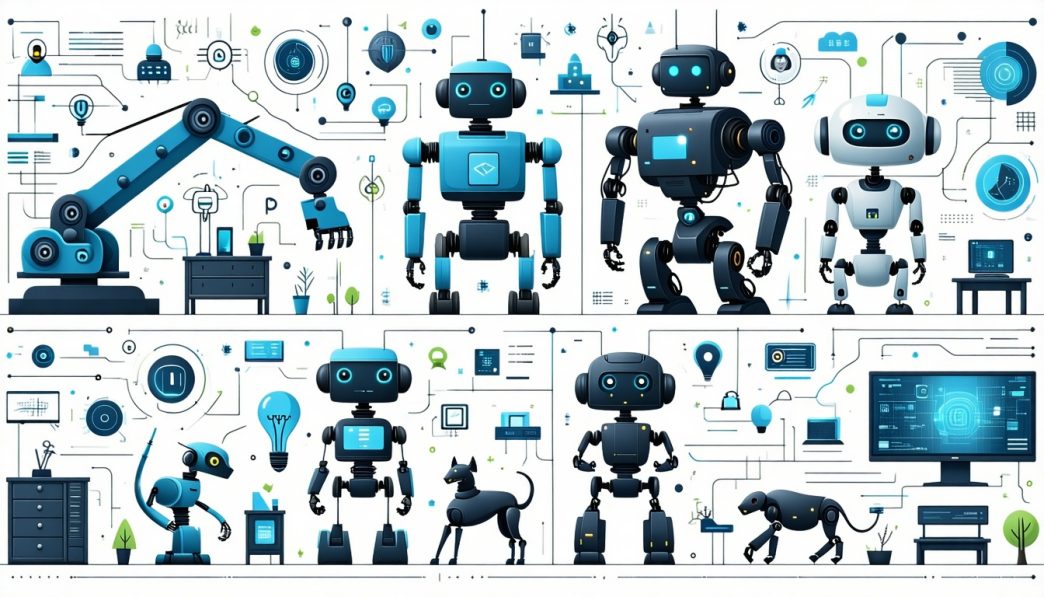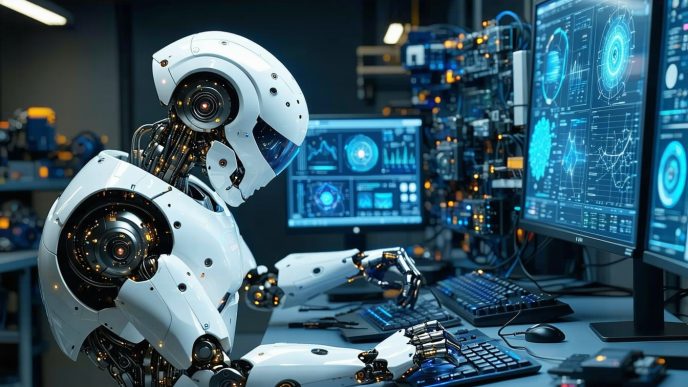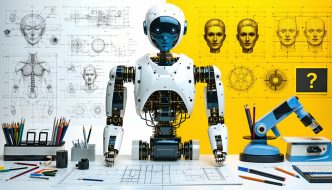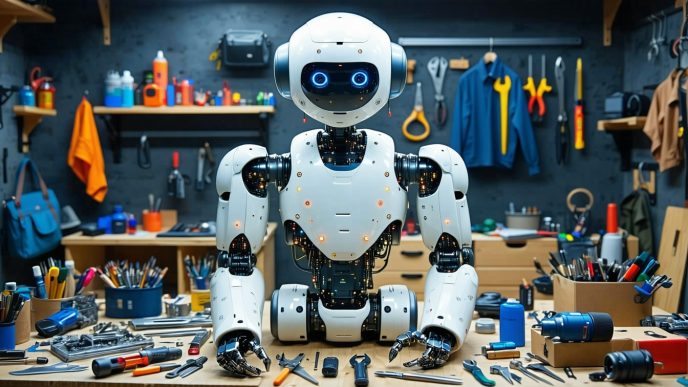Introduction to Humanoid Robots
Humanoid robots have captured the imagination of many, transforming from simple machines into sophisticated entities that mimic human behaviors. Understanding their evolution and the various types available is crucial for anyone interested in robotic technology.
Evolution of Humanoid Robots
The journey of humanoid robots began decades ago, with early designs focusing on simple mechanical movements. Over time, advancements in technology have greatly improved their capabilities. Modern humanoid robots can perform complex actions, recognize speech, and even interact with humans in a meaningful way.
| Year | Milestone in Humanoid Robot Development |
|---|---|
| 1950s | Early prototypes with basic motions introduced. |
| 1990s | Introduction of robots like ASIMO, showcasing advanced mobility. |
| 2000s | Robots began to incorporate AI, enabling learning and adaptation. |
| 2020s | Current robots feature enhanced interaction, emotion recognition, and autonomy. |
Notable examples include the Tesla Optimus Robot and the Xiaomi CyberOne, which display remarkable versatility in their applications.
Importance of Understanding Robot Types
With a wide variety of humanoid robots available, understanding the different categories is essential for potential owners. Each type has its unique features and applications, making some more suitable for specific needs than others. For instance, while some humanoid robots are designed for companionship, others focus on providing assistance in elder care or performing daily chores. Recognizing these distinctions can significantly influence decision-making for those considering the acquisition of a humanoid robot.
| Robot Type | Key Features | Typical Use Cases |
|---|---|---|
| Companion Robots | Emotion recognition, interactive dialogue | Personal companionship, mental health support |
| Service Robots | Task automation, navigation capabilities | Healthcare, elder assistance, household chores |
| Educational Robots | Learning algorithms, programming interfaces | Teaching tools in schools, robotics education |
| Research Robots | Advanced AI, experimental capabilities | Academic research, AI development |
As the technology continues to evolve, keeping informed about the different options available can help robot enthusiasts make decisions that align with their interests and needs. Exploring categories like humanoid robots for home use or applications in healthcare can guide prospective owners to understand what they specifically need.
Assessing Your Needs
Understanding your requirements before acquiring a humanoid robot is essential. This section covers identifying the specific purpose for the robot and evaluating the technical skills needed for successful operation.
Identifying Your Purpose for a Robot
First and foremost, one must consider why they need a humanoid robot. The purpose significantly influences the type of robot that may be suitable, as different robots are designed for various tasks. Here are some common purposes for using humanoid robots:
| Purpose | Description |
|---|---|
| Home Assistance | Robots that help with daily chores such as cleaning and cooking, like humanoid robots for daily chores. |
| Education | Robots that aid in learning, such as those used in classrooms or for tutoring, including humanoid robots for education. |
| Companionship | Robots designed to provide company and support emotional needs, refer to humanoid robots for companionship. |
| Security | Robots used for surveillance and protecting property, detailed in humanoid robots for security. |
| Healthcare | Robots intended for medical support or assisting healthcare professionals, like those discussed in humanoid robots in healthcare. |
By clearly defining the objective for a humanoid robot, an owner can make informed decisions about the features and functionalities required, which can lead them to the best options available.
Evaluating Your Technical Skills
The next step in assessing needs involves evaluating one’s technical expertise. The level of technical skill significantly determines how easily one can operate and maintain the robot.
Consider the following skill levels when determining compatibility:
| Skill Level | Description | Recommended Robot Features |
|---|---|---|
| Beginner | Little to no technical knowledge. | User-friendly interfaces, minimal programming required, and straightforward troubleshooting options. Examples include basic home assistant robots like the xiaomi cyberone. |
| Intermediate | Some familiarity with technology and programming. | Greater customization options, programming capabilities, and device integrations. Consider models like unitree g1 robot. |
| Advanced | High-level expertise, comfortable with complex systems. | Advanced features such as AI integration, custom software applications, and hardware modifications as seen in models like tesla optimus robot. |
Understanding one’s technical skills is vital in selecting a robot that not only meets their needs but is also manageable and enjoyable to operate. By recognizing both the purpose and personal skill level, individuals will have a clearer path forward in their humanoid robot journey.
Understanding the Different Robot Types
Choosing the right humanoid robot is essential for meeting specific needs and preferences. This section highlights the various types of humanoid robots and the key features and functions to consider when selecting one.
Types of Humanoid Robots
Humanoid robots can be categorized based on their intended usage and capabilities. Below is a table that outlines some common types:
| Type of Humanoid Robot | Description | Common Uses |
|---|---|---|
| Companion Robots | Designed to interact with humans and provide companionship | Elder care, social interaction |
| Service Robots | Assist with tasks in various settings like homes and businesses | Hospitality, personal assistance |
| Educational Robots | Aimed at teaching and enhancing learning experiences | Classrooms, workshops |
| Research Robots | Used for research and development in robotics | Universities, labs |
| Industrial Robots | Serve in manufacturing and production environments | Assembly lines, logistics |
For example, a companion robot might be suitable for elderly care, while a service robot could help with daily chores. Individuals seeking to understand more about specific applications can refer to articles on humanoid robots in elder care and humanoid robots for daily chores.
Features and Functions to Consider
Selecting a humanoid robot involves evaluating various features that enhance its performance and usability. Some of the most important features include:
| Feature | Description |
|---|---|
| Mobility | The ability to move freely and navigate spaces. Consider options like humanoid robot locomotion systems. |
| Communication | The capacity to convey information through voice or text, often facilitated by voice interfaces in humanoid robots. |
| Sensory Capabilities | Features like cameras or sensors that allow the robot to perceive its environment. Look into the topic of humanoid robot sensors. |
| Customization | Options to modify the robot’s appearance or functions to better suit individual needs, as discussed in humanoid robot customization. |
| Connectivity | The ability to integrate with other smart devices or networks, often connected to humanoid robots in smart homes. |
By understanding the types of humanoid robots and considering various features and functions, prospective owners can make informed decisions that align with their needs. Exploring market trends and available models can help for those interested in the latest innovations in robot technology, such as best humanoid robots 2025.
Factors to Consider Before Buying
When considering the purchase of a humanoid robot, there are several critical factors that potential owners must evaluate. These considerations include budgeting, maintenance and support options, and the programming and compatibility of the robot.
Budget Consideration
The cost of humanoid robots can vary widely based on their capabilities and features. It’s important for owners to establish a budget before beginning their search. Potential buyers should consider not only the initial purchase price but also ongoing costs related to maintenance and updates.
| Robot Type | Estimated Cost Range |
|---|---|
| Basic Robot for Home Use | $1,000 – $3,000 |
| Advanced Robot with AI Capabilities | $10,000 – $30,000 |
| Specialty Robots for Specific Tasks | $5,000 – $50,000 |
Understanding the financial commitment will help owners make informed decisions about which robot fits their needs. More details can be found in our article on humanoid robot costs.
Maintenance and Support
Owning a humanoid robot often involves routine maintenance and technical support. It is essential for owners to understand the maintenance requirements for their selected robot. Some robots may require regular software updates or hardware maintenance.
| Maintenance Tasks | Frequency |
|---|---|
| Software Updates | Monthly or as needed |
| Hardware Checks | Quarterly |
| Battery Maintenance | Annually |
The availability of customer support is also a key factor. Owners should verify whether the manufacturer provides assistance and how readily available that support is. More information on care and upkeep can be found in our article on humanoid robot maintenance.
Programming and Compatibility
Another crucial aspect to consider is the programming and compatibility of the humanoid robot. Owners should assess whether the robot can be easily programmed to perform specific tasks that align with their needs.
| Considerations | Questions to Ask |
|---|---|
| Programming Language | Is it user-friendly and accessible? |
| Third-Party Compatibility | Can it integrate with existing systems? |
| Open Source | Is the software customizable for specific applications? |
Confirming these features will enhance the ownership experience and ultimately determine the robot’s utility in the owner’s environment. For further details on software functions and integration, refer to our article on humanoid robot software platforms.
By carefully weighing these factors, potential robot owners can make a more informed decision that aligns with both their budget and technological capabilities.
Upgrading Your Robot
Upgrading a humanoid robot can significantly enhance its capabilities and overall performance. Understanding the benefits of such upgrades, compatibility with existing systems, and the importance of software and firmware updates can help owners make informed decisions.
Benefits of Upgrading
Upgrading provides several advantages for robot owners. Some of the key benefits include:
| Benefit | Description |
|---|---|
| Enhanced Features | New upgrades often introduce innovative features that can improve functionality and performance. |
| Improved Efficiency | Upgrades can streamline processes, making the robot more efficient in task completion. |
| Bug Fixes | Software updates frequently address existing issues, providing a smoother experience. |
| Access to New Technology | Owners can take advantage of advancements in AI and robotics without purchasing a new device. |
These benefits ensure that the humanoid robot remains competitive and capable of meeting evolving needs.
Compatibility with Existing Systems
When considering an upgrade, it’s essential to assess compatibility with existing systems. Owners should check the following:
| Compatibility Aspect | Considerations |
|---|---|
| Hardware | Ensure that the hardware can support the new upgrades without requiring significant modifications. |
| Software | Verify that the existing software platform can accommodate the new features and updates. |
| Integration | Assess how well the upgraded robot integrates with other systems or devices within your smart home or environment. |
Compatibility issues can hinder performance, making it crucial for robot owners to perform due diligence before upgrading.
Software and Firmware Updates
Keeping a humanoid robot’s software and firmware up to date is vital for optimal performance. Regular updates can provide:
| Update Type | Purpose |
|---|---|
| Software Updates | Enhance usability, add new features, and improve user interfaces. |
| Firmware Updates | Optimize hardware functionality and increase system stability. |
Maintaining an updated robot not only improves its functionality but also helps ensure that safety protocols are adhered to. For more information on the importance of software platforms and their role in upgrading, see our article on humanoid robot software platforms.
Safety and Ethical Considerations
The integration of humanoid robots into daily life raises important safety and ethical issues that every owner should understand. This knowledge is essential for responsible usage and ensuring the advancement of robotics benefits society.
Robotics Ethics
The ethical implications surrounding humanoid robots extend beyond their functionality. Owners need to consider how these machines interact with people and their impact on daily life. For example, the presence of humanoid robots in sensitive environments such as healthcare or elder care introduces ethical questions regarding consent, companionship, and emotional interaction.
Several ethical principles should be considered by robot owners:
| Ethical Principle | Description |
|---|---|
| Transparency | Ensuring that users understand how robots operate and make decisions. |
| Accountability | Determining who is responsible for the actions and decisions made by robots. |
| Privacy | Protecting the user’s personal data and privacy during robot interactions. |
| Inclusion | Ensuring that robotic systems are designed for accessibility for all users. |
Discussions around robot emotions and ethics and robot personalities and branding are vital in shaping the future of humanoid robots in society.
Safety Protocols and Practices
Safety is a paramount concern when utilizing humanoid robots. Implementing safety protocols helps mitigate risks associated with their operation in residential, commercial, and industrial settings. Owner awareness of these practices is crucial.
Important safety protocols include:
| Safety Measure | Description |
|---|---|
| Emergency Shutdown | A clearly defined method to disable the robot in case of malfunction or dangerous behavior. |
| User Training | Comprehensive training for users to understand the robot’s functionalities and limitations. |
| Regular Maintenance | Scheduled checks to ensure the robot operates within safety standards and its parts are functioning correctly. |
| Environment Security | Creating a safe operating area that minimizes hazards to humans and the robot itself. |
Robotic safety systems play a key role in preventing accidents. Owners should familiarize themselves with humanoid robot safety systems to ensure a safe operating environment.
Adopting these safety measures and ethical considerations helps ensure responsible ownership and fosters a positive relationship between humans and robots.














